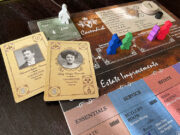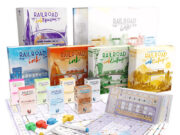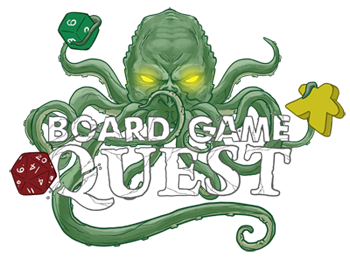 With formative years in the 1980s, this reviewer was exposed to some significant films all trying to duplicate the success of Alien (1979). It was a decade of renewed interest in sci-fi horror and just about every studio grabbed an available visual effects team, trapped some actors in a remote outpost, and let a ravenous beast run wild for the camera. Three films from 1989 at the end of this era stand out especially for their use of an undersea installation: Deep Star Six (mining crew uncovers ravenous ancient creature), Leviathan (mining crew discovers derelict sub with a pathogen turning them into creatures), and The Abyss (underwater drilling crew meets Earth-aliens while working with evil military guys). Feel free to take a moment to go watch. Then you can come back and share some of this reviewer’s perspective.
With formative years in the 1980s, this reviewer was exposed to some significant films all trying to duplicate the success of Alien (1979). It was a decade of renewed interest in sci-fi horror and just about every studio grabbed an available visual effects team, trapped some actors in a remote outpost, and let a ravenous beast run wild for the camera. Three films from 1989 at the end of this era stand out especially for their use of an undersea installation: Deep Star Six (mining crew uncovers ravenous ancient creature), Leviathan (mining crew discovers derelict sub with a pathogen turning them into creatures), and The Abyss (underwater drilling crew meets Earth-aliens while working with evil military guys). Feel free to take a moment to go watch. Then you can come back and share some of this reviewer’s perspective.
So, what should a game about an underwater installation have in it? Certainly, there is a chance for alternative resources to be used. A good dose of science concepts would be nice. And definitely, maybe some interaction with the various life forms could make a good source of tension. Deep Shelf, Ninth Haven Games’ latest release off Kickstarter success, has a mixture of these and this review DIVES in to see if the game has just enough ballast to provide a smooth ride. For those that need the details, Deep Shelf is a 3X underwater exploration and mining game for 1-4 players that takes about 40 minutes per player.
Gameplay Overview:
The general game concept is that each player is a faction intent on exploring and exploiting an offshore ocean area for minerals, control of the shelf, and science. Players are equipped with personal boards laden with various structures waiting to be built and scientists waiting to be deployed to help improve actions for victory point acquisition.
The main board is a hexagon map divided into 3 zones: the Shallows, the Deep, and the Trench. Players start at their Dock in the Shallows with an upgradable submarine that can move and explore tiles in each hex. These tiles mostly contain resources (Gold, Palladium, Osmium), anomalies that can be Extracted, or various bonuses to help players move or build facilities. As part of their Dock, players also have an area of their board called their “Surface Storage”, which are spaces ready to hold resources to be used in Science actions.

There are two types of structures that players can build on the map: facilities and transport tubes. Facilities are larger buildings that help players do big things: Extract resources (Extractors), Process resources (Smelters), conduct Research with Scientists, or reduce working costs with Worker Complexes. Each player faction also has a unique structure which also provides a unique action in the game. Meanwhile, transport tubes are “connecting” pieces that allow for another unit, Crawlers, to move between hexes occupied by the owning faction. This is necessary as Crawlers are one of the main ways to move resources across the map which is necessary to get them close to a Smelter or close to the home Dock.
How players interact with the components above is through the use of action cards. Each player is given a set of seven faction-specific action cards. Six of these are the same for each player while the seventh contains a unique action if a player builds their unique major facility. On a turn, a player plays an action card above their player board and follows all its instructions. They then play a second action card which becomes “Exhausted” and unavailable on their next turn. These action cards highlight the major activities that players will be attempting to accomplish in the game:
- Move – Move the Submarine and Crawlers
- Extract – Bring resources to the surface from Extractors and your Submarine
- Science – Purchase submarine upgrades and advance on the 3 science tracks
- Build – Construct a facility and/or tubes
- Process Ore – Unrefined resources may be improved to refined resources necessary for Science actions
- Loading Dock – Return the Submarine to the Dock, load resources onto the Surface Storage, and sell resources to the Market
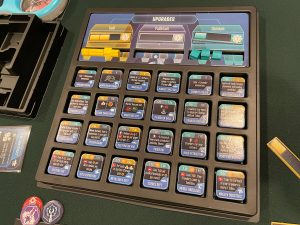
There are a couple more game elements to consider in play. Moving the Submarine or Crawlers through the more valuable Deep or Trench hexes requires spending additional movement points. When a player has extracted all the possible minerals from a hex, they flip the hex over which could advance the marker on the Exploitation track. This track keeps players aware of how close the players are to the shelf’s Environmental Collapse. Each time the track advances to a specific space, an Exploitation Event card is resolved. These will adjust the market prices for resources, move the Deep Dragon (see below), and create some other event.
The Deep Dragon is an enormous serpent creature that haunts the Deep just waiting to harass players. In game terms, this means that any extracted resources in hexes where the Deep Dragon moves are destroyed. In addition, players with facilities that are on a specific side of the Deep Dragon will gain negative victory points at the end of the game.
A game ends after one player moves to the end of all research tracks or if the movement of the marker on the Exploitation track results in Environmental Collapse. This latter condition depends on the number of players in the game.
For the player with the most points, the game rules declare they “assume command of the Deep Shelf Project!”

Game Experience:
When described in the abstract, everything in Deep Shelf sounds fantastic. The ideas are mostly interesting and engaging with just enough Euro-calculation mixed with a cool theme and fun components. However, the Devil Deep Dragon is in the details. Let’s go through a few of them.
Overall, the theme in Deep Shelf is expansive and epic with players moving their submarine around the map exploring and revealing deposits of valuable resources and other sites to interact with. As the game develops, the focus migrates to the players’ ability to extract and move resources to locations to be refined or utilized for building a tube network. Deep Shelf’s focus on expansion, extraction, and building generally does a good job of engaging players who enjoy engine building games. In some ways, it feels like a real-time strategy video game with players aggressively eyeing each other across the table to see who will claim a hex first.

As for a player’s turn, the first use of the action cards feels intuitive and not cumbersome. However, after a couple of rounds, the fact that the second card played becomes a dead card for a turn can really make planning for turns stumble. Many other games use a similar system but it’s only with single actions and helps reinforce that you can’t take the same action repeatedly. Why this specific twist on a reliable mechanism is present seems very unclear and rather than encouraging tough decisions, just makes preparing for a turn complex for complexity’s sake. Some cards do have a “powered up” task on the card which is only activated if placed in this second spot, but again, late in the game the action system feels cumbersome for planning and not engaging.
In addition, the completion of each card’s instructions left a lot to be desired. Some of this is due to the card design but also the nuances of the game mechanism’s restrictions must share some frustration. For example, for one of the most basic tasks, moving units, the limitations of movement in The Deep and the limitations of Crawler movement with tubes are not listed anywhere and must be committed to memory. Restrictions on building facilities are also listed in the rules only and must be referred to until memorized. These annoyances with card design and restrictions may seem minor, but they really distract from the elegance of play and force players to exert additional mental energy towards adhering to the rules of the actions rather than enjoying the strategy.

This also extends to some of the overarching game task loop. In general, players are exploring tiles, harvesting resources, moving resources, refining resources, delivering some resources to the surface, and completing upgrades. Now along the way, players need to build (at least usually) three different structures, and usually to win want to build their unique structure. All of the pressure to build these structures in just the right location is countered by opponents trying to do the same while trying to decide which hexes need to have an Extractor facility vs extracted via the Submarine.
The one major twist in the game happens once the players start depleting tiles of resources. When an Exploitation Event causes the Deep Dragon to move, it specifically moves from a player’s choice of where to move it. Besides being a sort of an “attack”, the placement causes the targeted player to lose up to 2 points. This is pretty minor and the more impactful effect is that the dragon destroys resources and denies a player the ability to build in a space. How much this impacts is very dependent on the way players approach the game. For more hard science fiction fans, this game element feels too fantastical. For those who want more interaction with sea creatures, it can feel very minor and non-eventful. For both these reasons, it definitely feels like a game element that could have been eliminated in favor of something else to drive interaction.
The major positive elements of the game are fine and go a long way to shore up the gameplay that the exceptional components and theme promise. The unique facility meeples are interesting and their abilities give a strong identity to each faction. Deep Shelf does a good job of drawing players into the action but then stumbles as it tries to hold them in those moments.

Final Thoughts:
The easiest way to see the complication of Deep Shelf’s design is through its end game victory point table. The game wants players to expand and move into the deeper area of the shelf, but at the same time, it rewards upgrading the player’s single submarine which is a competition for quantity over quality of upgrades. In addition, the competition for the remainder of the victory points feels more like an “oh yeah you can get these too” instead of driving players clearly towards goals. On the whole, Deep Shelf promises a lot but it stumbles in delivering a streamlined elegant game.
Final Score: 3 stars – A great idea and some interesting gameplay that is hampered by unrefined concepts leading to a not-so-smooth experience.
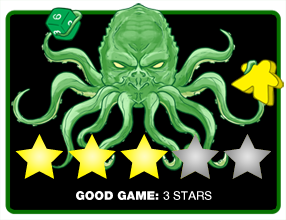 Hits:
Hits:
• Good theme integration with mechanisms
• Resources and meeples are well-designed for their function
Misses:
• Action system is overly complex
• Victory points feel cumbersome
• Feeling of progress is slow



